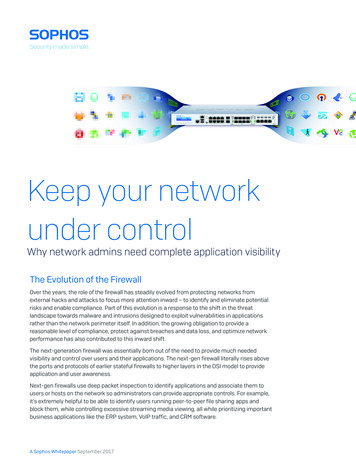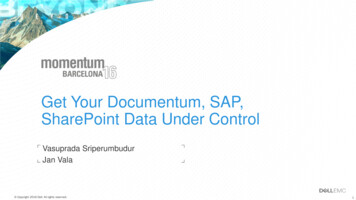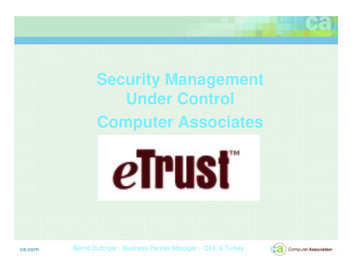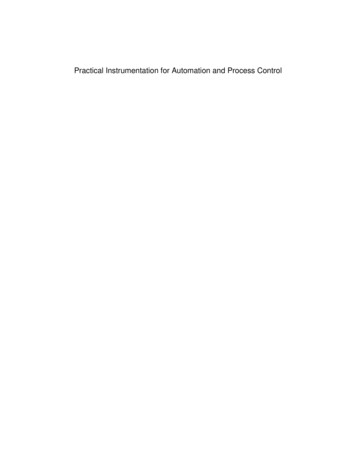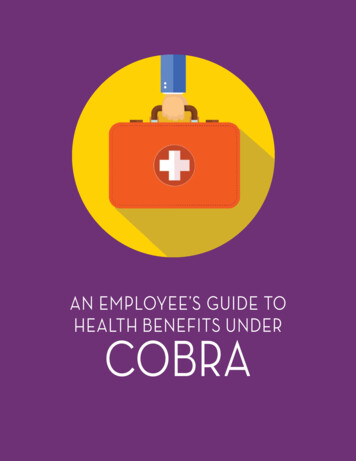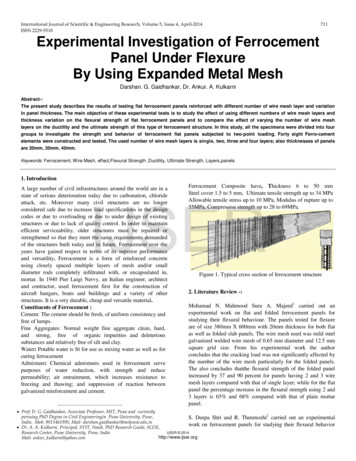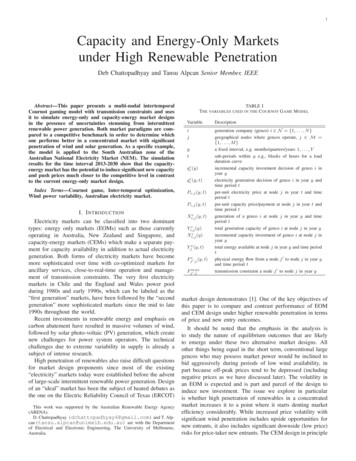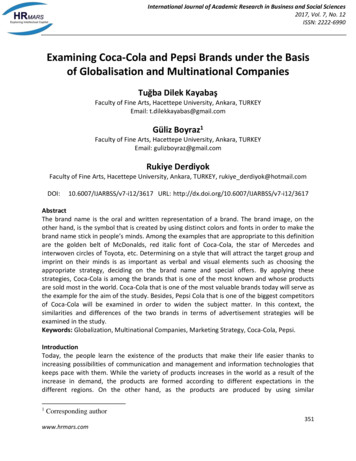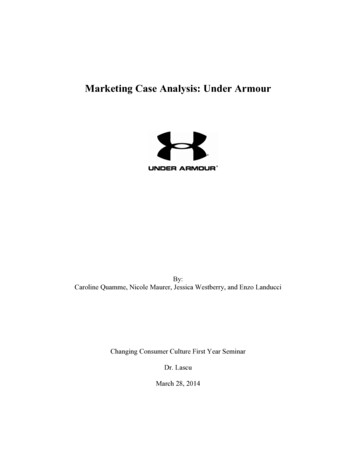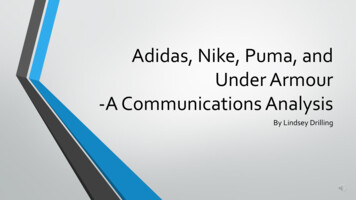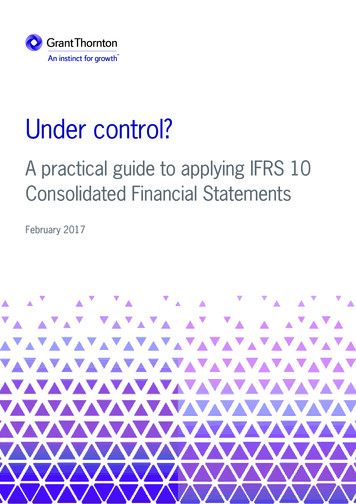
Transcription
Under control?A practical guide to applying IFRS 10Consolidated Financial StatementsFebruary 2017
Under control? A practical guide to IFRS 10ContentsIntroduction41 Overview61.1 Summary of IFRS 10’s main requirements71.2 Areas where IFRS 10 can affect the scope of consolidation91.3 IFRS 10 in the context of the overall ‘consolidation package’101.4 Effective date and Transition of IFRS 10112 Scope and consolidation exemptions122.1 Scope of IFRS 10132.2 Consolidation exceptions and exemptions143 The control definition and guidance163.1 The practical implications of the control definition183.2 The three key elements of control in more detail193.3 Purpose and design of investee303.4 Situations where the control assessment is unclear313.5 Summary of the control assessment process323.6 Continuous assessment33
Under control? A practical guide to IFRS 104 Applying the control model in specific circumstances344.1 Majority holdings in an investee354.2 Large minority holdings in an investee364.3 Potential voting rights404.4 Special purpose and structured entities434.5 Principal-agent situations504.6 Franchises585 Consolidation procedures605.1 The consolidation process615.2 Changes in non-controlling interests715.3 Losing control of a subsidiary736 Investment Entities766.1 Definition of an investment entity776.2 Applying the definition816.3 Accounting treatment for an investment entity86Appendix – Disclosures under IFRS 12: Understanding the requirements92
IntroductionAssessing when one entity controls another (in other words, when a parent-subsidiaryrelationship exists) is essential to the preparation of financial statements in accordancewith International Financial Reporting Standards (IFRS). The control assessment determineswhich entities are consolidated in a parent’s financial statements and therefore affects agroup’s reported results, cash flows and financial position – and the activities that are ‘on’and ‘off’ the group’s balance sheet. Under IFRS, this control assessment is accounted forin accordance with IFRS 10 ‘Consolidated financial statements’.
Under control? A practical guide to IFRS 10IFRS 10 was issued in May 2011, and was part of a package of changes addressingdifferent levels of involvement with other entities. IFRS 10 redefines ‘control’ and providesextensive guidance on applying the definition.IFRS 10 applies both to traditional entities and to specialpurpose (or structured) entities and replaced the correspondingrequirements of both IAS 27 ‘Consolidated and SeparateFinancial Statements’ (IAS 27) (2008) and SIC-12 ‘Consolidation– Special Purpose Entities’ (SIC-12).It is unusual for IFRS 10 to affect the scope of consolidationin simple situations involving control through ownership of amajority of the voting power in an investee. However, morecomplex and borderline control assessments need to bereviewed carefully.The member firms within Grant Thornton International Ltd(‘GTIL’) have gained extensive insights into the application ofIFRS 10. GTIL, through its IFRS team, develops generalguidance that supports its member firms’ commitment to highquality, consistent application of IFRS. We are pleased to sharethese insights by publishing ‘Under Control? A Practical Guide toApplying IFRS 10 Consolidated Financial Statements’ (the Guide).Using the GuideThe Guide has been written to assist management in applyingIFRS 10. More specifically it aims to assist in: understanding IFRS 10’s requirements identifying situations in which IFRS 10 can impact controlassessments identifying and addressing the key practical applicationissues and judgements.The Guide is organised as follows: Section 1 provides an overview of IFRS 10 and areaswhere IFRS 10 can impact the scope of consolidation. Italso explains how IFRS 10 fits into the overall package ofStandards on involvement with other entities. Section 2 explains the scope of IFRS 10 from an investorand investee perspective, and the situations in which aparent entity is exempt from presenting consolidatedfinancial statements. Section 3 sets out IFRS 10’s control definition and its keyelements, and identifies key practical issues in applying theguidance. Section 4 discusses the specific situations and types ofinvestee for which IFRS 10 can affect control conclusionsand the scope of consolidation in practice. Section 5 discusses consolidation procedures and therequirements on changes in ownership and loss of control. Section 6 explains the consolidation exception forinvestment entities. Appendix A summarises the disclosure requirements inIFRS 12 ‘Disclosure of Interests in Other Entities’ andprovides selected application examples.Grant Thornton International LtdFebruary 2017When applying IFRS 10, complex andborderline control assessments need tobe reviewed carefully.February 20175
1 OverviewIFRS 10 establishes a single, control-based model for assessing control and determiningthe scope of consolidation. It applies to all entities, including ‘structured entities’, whichwere previously referred to as ‘special purpose entities’ under SIC-12.
Under control? A practical guide to IFRS 10This section summarises IFRS 10’s main requirements, provides insights into areaswhere IFRS 10 most often impacts consolidation assessments and explains howIFRS 10 fits into the broader ‘consolidation package’.1.1 Summary of IFRS 10’s main requirementsSummary of IFRS 10’s main requirementsObjectiveScope and exemptionsIFRS 10 establishes principles for the presentation and preparation of consolidatedfinancial statements. To meet this objective it: requires an entity that controls another (a parent) to present consolidated financialstatements (subject to limited exemptions – see below) defines ‘control’, and confirms control as the basis for consolidation provides guidance on how to apply the definition provides guidance on preparing consolidated financial statements.IFRS 10 applies to all entities (including structured entities) except long-termemployment benefit plans within the scope of IAS 19 ‘Employee Benefits’.A parent that is itself a subsidiary of another entity (an intermediate parent) need notpresent consolidated financial statements if it meets strict conditions, including that: none of its owners object its shares/debt instruments are not traded in a public market a higher-level parent produces publicly-available IFRS consolidated financial statements.A parent that is an investment entity must not present consolidated financial statementsif it is required to measure all of it subsidiaries at fair value through profit or loss.IFRS 10 applies only to consolidated financial statements. Requirements onpreparing separate financial statements are retained in IAS 27.Control definitionAn investor controls an investee when it is exposed, or has rights, to variable returnsfrom its involvement with the investee and has the ability to affect those returnsthrough its power over the investee. Control requires: power over the investee exposure, or rights, to variable returns ability to use power to affect returns.February 20177
Under control? A practical guide to IFRS 10Summary of IFRS 10’s main requirementsApplying thecontrol definitionIFRS 10 includes additional guidance on the elements of the control definition and theirinteraction, including: purpose and design of the investee the ‘relevant activities’ of an investee whether the rights of the investor give it the current ability to direct the relevant activities whether the investor is exposed, or has rights, to variable returns.IFRS 10 includes guidance on more difficult control assessments including: agency relationships control over structured entities potential voting rights control without a majority of voting rights.Preparing consolidatedfinancial statementsEffective date and transitionIFRS 10 retains established principles on consolidation procedures, including elimination of intra-group transactions and the parent’s investment: uniform accounting policies the need for financial statements used in consolidation to have the same reporting date the allocation of comprehensive income and equity to non-controlling interests accounting for changes in ownership interests without loss of control accounting for losing control of a subsidiary.IFRS 10 came into effect for accounting periods beginning on or after 1 January 2013.Transition was mainly retrospective but was subject to reliefs for situations in which: the control assessment was the same as under IAS 27 (2008) a fully retrospective consolidation or de-consolidation would be impracticable.Early adoption was permitted as long as the other standards in the consolidationpackage were adopted at the same time.DisclosuresIFRS 10 does not include any disclosure requirements but an entity that appliesIFRS 10 is also required to apply IFRS 12 – which sets out comprehensivedisclosure principles.Terminology – ‘special purpose entities’ (SPEs) and ‘structured entities’The Guide makes extensive references to ‘special purpose entities’ (SPEs). These references are used to broadly describe entitieswhich used to be considered within the scope of SIC-12. SIC-12 described SPEs only in general terms, so deciding whether aparticular entity is an SPE required judgement.IFRS 10 does not refer to SPEs, but instead refers to entities that have been designed so that voting or similar rights arenot the dominant factor in assessing control. These are described as ‘structured entities’ in IFRS 12. IFRS 10 includes applicationguidance for assessing control over such entities.In practice we believe that most (but not all) entities previously regarded as SPEs under SIC-12 are structured entitiesunder IFRS 10.This is explained in more detail in section 4.4.1.8February 2017
Under control? A practical guide to IFRS 101.2 Areas where IFRS 10 can impact the scope of consolidationIt is unusual for IFRS 10 to affect the scope of consolidation instraightforward situations involving control through majorityownership of voting power. However, more complex andborderline control assessments need to be reviewed carefully.The table below summarises the main situations and typesof investee in which IFRS 10 can impact control assessmentsand scope:Situations/type of investeeImpact of IFRS 10Large minority holdings control may exist where other shareholdings are widely dispersed and an investor holdssignificantly more voting rights than any other shareholder or group of shareholders.Potential voting rights (PVRs) under IFRS 10 PVRs may convey or contribute to control if ‘substantive’ IFRS has a broad range of indicators to assess whether PVRs are substantive.Special purpose entities (SPEs) andstructured entities SPEs are not defined in IFRS 10 IFRS 10’s general principles apply to entities previously covered by SIC-12 consolidation outcomes for entities that were previously within the scope of SIC-12 canchange because:– exposure to risks and rewards is only an indicator of control under IFRS 10 and is notdeterminative of control on its own– IFRS 10 places less emphasis on the concept of ‘autopilot’ and instead requires amore specific identification of the future activities and decisions that can affect returns IFRS 10 does include guidance on situations in which voting or similar rights are not thedominant factor in deciding who controls the investee.Delegated power (principal-agentsituations) the guidance in IFRS 10 on principal-agent situations can impact on consolidation decisions investment and asset managers in particular can be affected IFRS 10 includes extensive guidance on whether an investor is a principal or an agent. Aninvestor engaged primarily to act on behalf of other parties (ie an agent) does not controlthe investee.Investment entities when the parent is an investment entity, IFRS 10 provides an exception to theconsolidation requirement.IFRS 10 establishes a single, control-basedmodel for assessing control anddetermining the scope of consolidation.February 20179
Under control? A practical guide to IFRS 101.3 IFRS 10 in the context of the overall ‘consolidation package’IFRS 10 was issued in May 2011 as part of a package ofthree new and two amended standards, sometimes referredto as the consolidation package. The other standards includedin this package were: IFRS 11 ‘Joint Arrangements’, which replaced IAS 31‘Interests in Joint Ventures’ and SIC-13 ‘Jointly ControlledEntities – Non-Monetary Contributions by Venturers’ IFRS 12 ‘Disclosure of Interests in Other Entities’ an amended version of IAS 27, which was renamed IAS 27‘Separate Financial Statements’ and addresses onlyseparate financial statements an amended version of IAS 28, which was renamed IAS 28‘Investments in Associates and Joint Ventures’, but issubstantively the same as the previous version.This Guide focuses on IFRS 10, although the relateddisclosure requirements in IFRS 12 are summarised inthe Appendix.The flowchart below summarises the interactions betweenIFRSs 10, 11 and 12 and IAS 28 for different levels ofinvolvement with an investee:Flowchart – Interactions between pronouncements in the ‘consolidation package’Outright control?NoJoint control?YesNoWhich type of jointarrangement?YesConsolidate(IFRS 10)JointoperationAccount for assets,liabilities etc(IFRS 11)Apply IFRS 12 disclosures10 February 2017Significant influence?JointventureEquity accounting(IAS 28/IFRS 11)YesEquityaccounting(IAS 28)NoFinancial assetacounting(IFRS 9)Apply IFRS 7disclosures
Under control? A practical guide to IFRS 101.4 Effective date and transition of IFRS 10IFRS 10 became mandatory for annual periods beginning on or after 1 January 2013.Earlier application was permitted, as long as this was disclosed and the other standards and amendments in theconsolidation package were applied at the same time – in particular IFRS 11 and IFRS 12 [IFRS 10.C1].In practice the transition from IAS 27
IFRS 10 was issued in May 2011, and was part of a package of changes addressing different levels of involvement with other entities. IFRS 10 redefines ‘control’ and provides extensive guidance on applying the definition. IFRS 10 applies both to traditional entities and to special purpose (or structured) entities and replaced the corresponding
